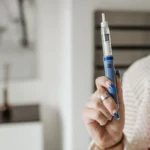Nephrogenic diabetes insipidus (NDI) is a rare condition that develops when the body becomes resistant to the effect of Vasopressin.
It is different from Central Diabetes Insipidus in which the body is not producing a sufficient amount of Vasopressin as a result of an abnormality in the pituitary or hypothalamus.
Diabetes Insipidus is totally different than Diabetes Mellitus. Mellitus means “sweet” while Insipidus means “bland“. As the name suggests, Diabetes Mellitus is a result of high plasma glucose resulting from either deficiency of insulin or resistance to the effect of insulin.
On the other hand, Nephrogenic Diabetes Insipidus is a result of the body’s unresponsiveness to Vasopressin.
The primary defect lies in the kidneys as the ADH receptors are not properly stimulated by Vasopressin.
What is Nephrogenic Diabetes Insipidus?
It is a distinct disorder in which the kidneys develop a partial resistance towards the hormone vasopressin (antidiuretic hormone).
Vasopressin or ADH is the hormone that manages water balance in the body, it maintains the absorption or retention of water.
In NDI this water balance is disturbed which causes excessive thirst, dehydration, and excessive urine production.
This condition should not be confused with diabetes mellitus which is caused by high plasma glucose resulting in excessive urination.
Go Organic | Try Dibesity’s Premium Catalogue
Causes of Nephrogenic Diabetes Insipidus:
Nephrogenic diabetes insipidus can be either inherited or acquired.
Congenital Nephrogenic Diabetes Insipidus:
Congenital means that these anomalies are present at birth. Most cases of NDI are due to the common X-linked recessive or dominant disorders however some rare cases might be caused by autosomal recessive disorders.
In X-linked recessive disease, the AVPR2 gene mutation is the most common cause. But this condition is still rare as it affects only 1 in 250,000 births.
This type of disease is more commonly found in men because women have 2 X chromosomes and usually 1 gene is affected and the other is normal, however, in men, only one recessive gene on the X chromosome can cause the disease.
Other 10% of the cases are caused due to mutation is autosomal and the affected gene is AQP2. This type equally affects both men and women.
Acquired Nephrogenic Diabetes Insipidus:
In acquired NDI, some external factors are the cause of the abnormal function of vasopressin. This can be either drug abuse or exposure to certain toxins.
The most common causative agent of acquired NDI is Lithium. Certain medications that are used to treat bipolar disorder contain lithium and long-term use of such medications damages kidney cells and causes acquired nephrogenic diabetes insipidus.
Kidney damage can be stopped if the drug use is avoided but in most cases, the disease is diagnosed late and kidney damage is permanent.
Some other factors that can be responsible for acquired NDI include:
- High calcium levels in the blood can damage kidney cells.
- Low levels of potassium in the blood – hypokalemia
- Kidney infections
- Kidney or ureter stones
Nephrogenic Diabetes Insipidus can also be associated with some cases of pregnancy.
Symptoms of Nephrogenic Diabetes Insipidus:
The symptoms of NDI greatly vary from person to person. And every form of the disease has a different expression of symptoms.
The congenital forms of the disease are more severe as compared to the acquired ones. If the disease is X-linked, the symptoms usually appear in the 1st year of life however if the disease is autosomal, the symptoms tend to appear later in the adult years.
In acquired forms, the disease has a slow progression and symptoms often appear in the late adult years of life.
Common symptoms in all age groups:
- Excessive thirst
- Excessive urination
- Lethargy
- Constipation
- Diarrhea
- Dry skin
Symptoms in infants
Some infants might present with vomiting, irritability, unexplained fevers, and frequent bedwetting.
- Failure to gain weight
- Physical and mental disability
- Brain damage
- Seizures
- Developmental delays
Symptoms in adults
- Orthostatic hypotension
- Swelling of ureters
- Hydronephrosis –accumulation of urine in kidneys
- Fatigue
- Dehydration
- Loss of consciousness
Diagnosis of Nephrogenic Diabetes Insipidus:
NDI is often confused with diabetes mellitus because of the common symptoms. A detailed clinical evaluation must be done that must include the patient’s family history, drug use, and specialized tests.
Diagnosis in children is often less complicated because most of the children present with polydipsia and polyuria are more likely to have NDI rather than Diabetes Mellitus.
Some clinical tests for the diagnosis of NDI include:
Urinalysis and urine osmolality:
Urine samples are taken to check the concentration of particles such as minerals, salts, or sugars and the ratio of these particles to water.
Individuals with NDI have a low osmolality of water in their urine, which means that the ratio of solid particles in urine is less than that of water.
Water deprivation test:
This test studies urine composition and urine output and determines the levels of vasopressin in the body in response to water deprivation. It determines the type of diabetes insipidus and also determines complete or partial NDI.
The patient is asked to stop taking water and urinary osmolality and weight is measured hourly. Once the patient loses 3% of body weight or the difference in urine osmolalities in 2 consecutive samples is less than 30 mOsm/kg, the person is given vasopressin.
In patients with Nephrogenic Diabetes Insipidus, the urine will not respond to vasopressin administration while in those with central DI, the urine volume will reduce and the urine osmolality will rise above 750 mOsm/kg.
Other tests include:
- X-rays
- CT scan (to differentiate between nephrogenic diabetes insipidus and central diabetes insipidus)
- Ultrasound (to detect any renal abnormalities)
- Serum calcium levels
- Drug levels like serum lithium levels.
Treatment of Nephrogenic Diabetes Insipidus::
The treatment of NDI is specific according to the symptoms that appear in each individual. Treatment requires a combined effort from a team of healthcare professionals including a pediatrician, nephrologist, nutritionist, and endocrinologist.
Medications for NDI:
Several medications are prescribed to decrease urine output such as hydrochlorothiazides, although these drugs increase urine output they can be used to lower it in patients with NDI.
These drugs can be used alone or in combination with others such as amiloride or indomethacin. Some NSAIDs can also be used to increase urine concentration but these might put an additional burden on the kidneys.
Dietary Modifications:
The main dietary modifications for NDI include increasing water intake and consuming a very low-sodium diet.
Adequate water intake is necessary to avoid dehydration. Infants with NDI need frequent water offerings or water might be given through tube feeding.
Sodium intake should be lowered to 0.5g/kg. A diet this low in sodium requires proper planning from expert dietitians so that only low-sodium foods are included in the daily meals.
Genetic Counseling:
Genetic counseling can be useful to prevent the genetic forms of NDI. Affected individuals and families should be counseled about the inherited forms of NDI.
Go Organic | Try Dibesity’s Premium Catalogue



